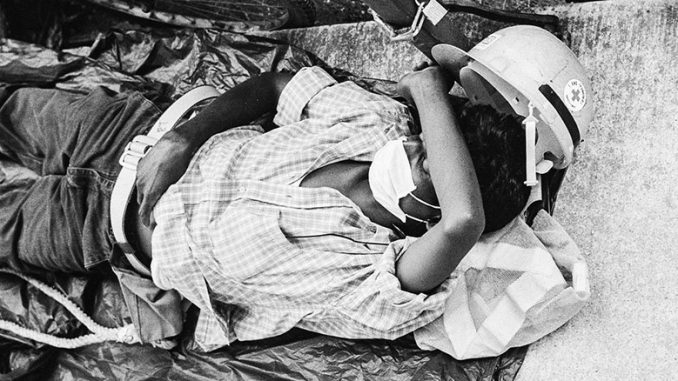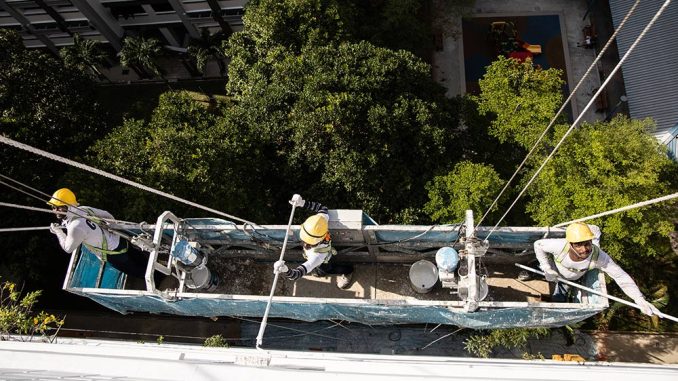
Throughout the Covid-19 crisis, Prime Minister Lee Hsien Loong and other high-ranking ministers of the Singapore government have repeatedly expressed gratitude to migrant construction workers for their role in building the gleaming city-state. These low-paid workers, mostly from India, Bangladesh and China, number in the hundreds of thousands within an overall population of roughly six million. Living in questionable conditions within industrial-sized dormitories – sometimes with twelve to a room – the construction workers have been the unfortunate victims of the coronavirus, with tens of thousands infected. The fact that these numbers have been exponentially higher than amongst Singapore citizens, permanent residents, and well-to-do expats is telling. A national debate has taken place on both working conditions and the role of migrant labour in country and, unsurprisingly, the government led by the long-ruling People’s Action Party (PAP) has attempted to set the tone, including through the aforementioned expressions of gratitude. The PAP government should certainly be commended for publicly recognizing the oft-ignored contributions of migrant labour to the country and should also be given credit for attempting to battle some of the ugly xenophobia that has reared its head during the crisis. It must be argued, however, that the PAP ought to be expressing their gratitude to the migrant workers for another reason. Indeed, the mass reliance on foreign labour is one factor that has allowed the PAP to remain in power for the last thirty years.
In the niche industry of explaining Singapore’s electoral authoritarian longevity, in recent years, the role of the working class has hardly featured. Although the co-optation of a once radical labour movement is understood as having been central to the development of PAP hegemony, the lack of subsequent democratization in Singapore has usually been pinned on the country’s middle class. This focus has not been unjustified. Modernization theory has long predicted that the development of a sizeable well-educated middle class is a factor highly conducive to democratization. In East Asia, gradual regime changes in South Korea and Taiwan spanning the 1980s and early 1990s, spawned by middle class insistence on a greater voice, appeared to have validated this theory. With the growth in size and sophistication of the middle class since the 1980s, Singapore has not been immune to similar pressures. Yet, unlike the aforementioned cases, the electoral authoritarian regime has remained firmly in place. As a result of this curiosity, analysts of Singapore politics have paid much attention to the ways in which the PAP party-state has managed to keep the middle class onside. The leveraging of state-controlled economic resources, the propagation of non-liberal ideology, and the use of non-democratic avenues for increased participation have all been employed by the PAP with increased intensity since the 1980s (Chua, 2017; Rodan, 2018; Thompson, 2019).
As accurate as such analyses have been, however, they have tended to gloss over the fact that another pressure point upon the regime has been effectively managed through the policies of the ruling party. This has been the alleviation of political pressure emanating from the Singapore-based working class. Alongside the emergence of the middle class, another key development of the 1980s was a restructuring of Singapore’s economy. As the government attempted to move the country up the ladder of the global supply chain in a new era of bourgeoning globalization, a segment of Singaporean manual labourers were left disgruntled with the restructuring. The return of opposition members of parliament in 1981 and in subsequent elections is often primarily attributed to the rise of middle class issues, including exhaustion with PAP paternalism and the desire for greater consultation. Nevertheless, the swing of some working class voters away from the PAP as a result of their globalization-oriented economic policies ought to be understood as an equally important factor. This pattern has continued into the 21st century, with the Workers’ Party capturing the predominantly blue-collared districts of Aljunied and Hougang.

Yet, despite these impactful shifts, they have been insufficient to engender a working-class-driven push for an opening up of the political system. This is despite the fact that inequality on the island has grown tremendously over the last several decades. One of the key reasons for this is the fact that much of the Singaporean working class has been replaced by foreign labour, in effect limiting the amount of pressure that Singaporean blue-collar workers have been able to place upon the state. Beginning in the late 1980s, the PAP government initiated a gradual increase in the number of low-wage temporary labourers, including construction workers but also domestic helpers. While in the early 1980s such workers numbered in the tens of thousands, by 2019 there were a total of 600,000. (Ministry of Manpower, 2020). Meanwhile, as a result of highly effective education policy and skills upgrading programs, many Singaporeans have been able to leap into the middle and upper classes, with 57% of locals now professionals, managers, executives or technicians (Mahmud, 2020). With the migrant labourers from China, India, and neighbouring Southeast Asian countries having had little choice but to accept working-poor wages and restrictions on their ability to permanently settle, the PAP government has not had to worry that their economic policy would bring about calls for either economic or political reform from their guests. This has allowed for the PAP to avoid the political turbulence that would surely have come had it pursued the same low-wage, high-growth economic policies with a predominantly local working class. For certain, had there been such an effort to employ Singaporeans in these industries at similar rates of compensation, it is likely that the PAP’s mechanisms for co-opting much of the local population would have been seriously challenged. It can thus be said that the migrant workers have been exploited both economically and politically.
While this steady stream of low-wage labour has been beneficial for Singapore’s economic growth over the last few decades, the PAP now faces a problem. After the Covid-19 crisis subsides, calls for a solution to the poor conditions faced by migrant workers will louden. However, potential solutions – better conditions for the workers or reincorporating Singaporeans into the affected industries – could result in both lower growth and greater costs passed on to the rest of the population. For a government that has relied on the improvement of local livelihoods for much of its legitimacy, such a shift would constitute a clear political risk. In an ironic twist of fate, the PAP has become dependent on the low-wage migrant workers. Those expecting substantial reforms from the ruling party shouldn’t hold their breath.
David Matijasevich
David Matijasevich is an instructor in the Political Science Department, Capilano University, Canada
Banner: Migrant resting migrant construction worker at Marina Bay, Singapore. Photo: Kevin Utting, Flickr.
References
Chua, B.H. (2017). Liberalism disavowed: Communitarianism and state-capitalism in Singapore. Singapore: NUS Press.
Mahmud, A. H. (2020, April 18). COVID-19: Forum letter on foreign worker dormitory cases reveals ‘underlying racism’, says Shanmugam. Channel News Asia. https://www.channelnewsasia.com/news/singapore/covid-19-letter-zaobao-foreign-worker-dormitory-racism-shanmugam-12654924
Ministry of Manpower. (2020, April 29). Foreign workforce numbers. https://www.mom.gov.sg/documents-and-publications/foreign-workforce-numbers
Rodan, G. (2018). Participation without democracy: Containing conflict in Southeast Asia. Ithaca, NY: Cornell University Press.
Thompson, M.R. (2019). Authoritarian modernism in East Asia. New York: Palgrave Macmillan.
